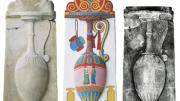The English essayist and critic William Hazlitt gazed on the white marble sculptures of antiquity and thought them cold. “[T]he finest statue in the world can only resemble a man turned to stone,” he wrote in 1824. “[S]culpture, though not proper to express health or life or motion, accords admirably with the repose of the tomb.” He should get a look at this.
“I knew, of course, that Greek and Roman sculpture was once painted,” says Susanne Ebbinghaus, Hanfmann curator of ancient art at the Harvard University Art Museums, “but there is a big difference between this abstract notion and actually attempting to imagine what the sculptures might have looked like.” Gods in Color: Painted Sculpture of Classical Antiquity is at the Arthur M. Sackler Museum through January 20. Organized by Munich’s Stiftung Archäologie and the Staatliche Antikensammlungen und Glyptothek, the exhibition drew crowds at home in 2004 and then began traveling. Athenians in long lines were fascinated and shocked. In Hamburg, says Ebbinghaus, some museum-goers proclaimed that Classical art was now dead for them. The enlivening color of these reconstructions has been brought to Harvard by Ebbinghaus and Amy Brauer, Beever associate curator of ancient art. Along with 22 painted, full-size copies of Greek and Roman originals, they display statues and reliefs from Harvard’s collection in their current, colorless, state.
The color reconstructions are based on close examination of the originals and on scientific analysis of the scarce traces of paint remaining on them. Ultraviolet light, says Ebbinghaus, “brings out ‘paint ghosts,’ differences in the surface structure of the stone caused by different paints and by the weathering of the paints. It can often give you an idea of patterns, even if no pigments survive.” The paint on these reproductions of stone sculptures appears flat, lacking the depth of, say, oil. “We can identify the colorants—mostly minerals and some plants,” says Ebbinghaus, “but binding media are hard to identify. Egg has been used for the reconstructions. If the minerals were ground more finely, a different binding medium used, the paint polished or covered with a protective coating, the effect would be quite different.”
“We now assume that almost all Greek marble sculpture was painted,” she says. “These reconstructions can only be approximations,” but at least they dispel a popular misconception—that most statues of antiquity were plain old white. Plain would not be thought ideal until the Renaissance.

Above: Trojan archer from the Temple of Aphaia on Aegina, Greek, c. 490-480 B.C. He is probably Paris, who killed Achilles with an arrow to that famous heel. He wears the costume of the Scythians of central Asia.

Above: Athena, from the same temple and of the same date. Reconstruction has been restricted to areas whose original appearance may be determined with some certainty.
 |  |
Above: Reclining lion, Greek, c. 550 B.C., and the head of Caligula (looking innocent), Roman, A.D. 39-41, both at Ny Carlsberg Glyptotek, Copenhagen.

Above: Torso of a warrior, Greek, c. 470-460 B.C., Acropolis Museum, Athens. The color of the cuirass is speculative, and both yellow and gilt reconstructions were made; some ancient statues certainly were gilded.

Above: A bronze head of a youth, Roman, early first century A.D., from the Staatliche Antikensammlungen und Glyptothek, Munich.

Above: Naked Greeks battle Persians on the so-called “Alexander” sarcophagus, Greek, c. 320 B.C., Archaeological Museum, Istanbul.

Above: The “Peplos” kore, Greek, c. 530 B.C., Acropolis Museum, Athens. The version at right was done first and drew criticism from those who say that the ancients painted only ornaments and details, never a whole sculpture. The second version is limited to colors that can be determined surely. “If there is color preserved on the hair of statues of Greek women and some men,” notes curator Susanne Ebbinghaus, “it is red. The red must have served as a base color, and so the yellow kore has been given brown hair.”
All color reconstructions of stone originals are by Vinzenz Brinkmann and Ulrike Koch-Brinkmann, joined for some pieces by Sylvia Kellner, Jan Stubbe Østergaard, Doris Lauenstein, Richard Posamentir, or Christian Wolters. The bronze head is by Olaf Herzog, Hagen Schaaf, and Raimund Wünsche. All reconstructions are loaned by the Stiftung Archäologie or the Staatliche Antikensammlungen und Glyptothek, Munich. Photographs are reproduced courtesy of the Stiftung Archäologie.






